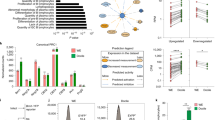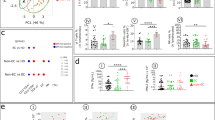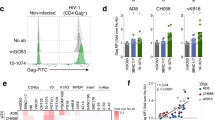Abstract
The humoral immune response after acute infection with HIV-1 is delayed and ineffective. The HIV-1 envelope protein gp120 binds to and signals through integrin α4β7 on T cells. We found that gp120 also bound to and signaled through α4β7 on naive B cells, which resulted in an abortive proliferative response. In primary B cells, signaling by gp120 through α4β7 resulted in increased expression of the immunosuppressive cytokine TGF-β1 and FcRL4, an inhibitory receptor expressed on B cells. Coculture of B cells with HIV-1-infected autologous CD4+ T cells also increased the expression of FcRL4 by B cells. Our findings indicated that in addition to mediating chronic activation of the immune system, viral proteins contributed directly to HIV-1-associated B cell dysfunction. Our studies identify a mechanism whereby the virus may subvert the early HIV-1-specific humoral immune response.
This is a preview of subscription content, access via your institution
Access options
Subscribe to this journal
Receive 12 print issues and online access
$209.00 per year
only $17.42 per issue
Buy this article
- Purchase on Springer Link
- Instant access to full article PDF
Prices may be subject to local taxes which are calculated during checkout








Similar content being viewed by others
References
Lawn, S.D., Butera, S.T. & Folks, T.M. Contribution of immune activation to the pathogenesis and transmission of human immunodeficiency virus type 1 infection. Clin. Microbiol. Rev. 14, 753–777 (2001).
Haas, A., Zimmermann, K. & Oxenius, A. Antigen-dependent and -independent mechanisms of T and B cell hyperactivation during chronic HIV-1 infection. J. Virol. 85, 12102–12113 (2011).
Lane, H.C. et al. Abnormalities of B-cell activation and immunoregulation in patients with the acquired immunodeficiency syndrome. N. Engl. J. Med. 309, 453–458 (1983).
Amadori, A., De Rossi, A., Faulkner-Valle, G.P. & Chieco-Bianchi, L. Spontaneous in vitro production of virus-specific antibody by lymphocytes from HIV-infected subjects. Clin. Immunol. Immunopathol. 46, 342–351 (1988).
De Milito, A. et al. Mechanisms of hypergammaglobulinemia and impaired antigen-specific humoral immunity in HIV-1 infection. Blood 103, 2180–2186 (2004).
Malaspina, A. et al. Deleterious effect of HIV-1 plasma viremia on B cell costimulatory function. J. Immunol. 170, 5965–5972 (2003).
Moir, S. & Fauci, A.S. B cells in HIV infection and disease. Nat. Rev. Immunol. 9, 235–245 (2009).
Cuss, A.K. et al. Expansion of functionally immature transitional B cells is associated with human-immunodeficient states characterized by impaired humoral immunity. J. Immunol. 176, 1506–1516 (2006).
Malaspina, A. et al. Appearance of immature/transitional B cells in HIV-infected individuals with advanced disease: correlation with increased IL-7. Proc. Natl. Acad. Sci. USA 103, 2262–2267 (2006).
Moir, S. et al. Evidence for HIV-associated B cell exhaustion in a dysfunctional memory B cell compartment in HIV-infected viremic individuals. J. Exp. Med. 205, 1797–1805 (2008).
Wilson, T.J., Fuchs, A. & Colonna, M. Cutting edge: human FcRL4 and FcRL5 are receptors for IgA and IgG. J. Immunol. 188, 4741–4745 (2012).
Sohn, H.W., Krueger, P.D., Davis, R.S. & Pierce, S.K. FcRL4 acts as an adaptive to innate molecular switch dampening BCR signaling and enhancing TLR signaling. Blood 118, 6332–6341 (2011).
Moir, S. et al. Normalization of B cell counts and subpopulations after antiretroviral therapy in chronic HIV disease. J. Infect. Dis. 197, 572–579 (2008).
Levesque, M.C. et al. Polyclonal B cell differentiation and loss of gastrointestinal tract germinal centers in the earliest stages of HIV-1 infection. PLoS Med. 6, e1000107 (2009).
Peruchon, S. et al. Tissue-specific B-cell dysfunction and generalized memory B-cell loss during acute SIV infection. PLoS ONE 4, e5966 (2009).
Haynes, B.F., Moody, M.A., Liao, H.X., Verkoczy, L. & Tomaras, G.D. B cell responses to HIV-1 infection and vaccination: pathways to preventing infection. Trends Mol. Med. 17, 108–116 (2011).
McMichael, A.J., Borrow, P., Tomaras, G.D., Goonetilleke, N. & Haynes, B.F. The immune response during acute HIV-1 infection: clues for vaccine development. Nat. Rev. Immunol. 10, 11–23 (2010).
Tomaras, G.D. & Haynes, B.F. HIV-1-specific antibody responses during acute and chronic HIV-1 infection. Curr. Opin. HIV AIDS 4, 373–379 (2009).
Shen, X. & Tomaras, G.D. Alterations of the B-cell response by HIV-1 replication. Curr. HIV/AIDS Rep. 8, 23–30 (2011).
Yates, N.L. et al. HIV-1 gp41 envelope IgA is frequently elicited after transmission but has an initial short response half-life. Mucosal. Immunol. 6, 692–703 (2013).
Naniche, D. Human immunology of measles virus infection. Curr. Top. Microbiol. Immunol. 330, 151–171 (2009).
Peacock, D.B., Jones, J.V. & Gough, M. The immune response to thetaX 174 in man. I. Primary and secondary antibody production in normal adults. Clin. Exp. Immunol. 13, 497–513 (1973).
Erle, D.J. et al. Expression and function of the MAdCAM-1 receptor, integrin α4β7, on human leukocytes. J. Immunol. 153, 517–528 (1994).
Arthos, J. et al. HIV-1 envelope protein binds to and signals through integrin α4β7, the gut mucosal homing receptor for peripheral T cells. Nat. Immunol. 9, 301–309 (2008).
He, B. et al. HIV-1 envelope triggers polyclonal Ig class switch recombination through a CD40-independent mechanism involving BAFF and C-type lectin receptors. J. Immunol. 176, 3931–3941 (2006).
Gorfu, G., Rivera-Nieves, J. & Ley, K. Role of β7 integrins in intestinal lymphocyte homing and retention. Curr. Mol. Med. 9, 836–850 (2009).
Szabo, M.C., Butcher, E.C. & McEvoy, L.M. Specialization of mucosal follicular dendritic cells revealed by mucosal addressin-cell adhesion molecule-1 display. J. Immunol. 158, 5584–5588 (1997).
Lehnert, K., Print, C.G., Yang, Y. & Krissansen, G.W. MAdCAM-1 costimulates T cell proliferation exclusively through integrin α4β7, whereas VCAM-1 and CS-1 peptide use α4β1: evidence for “remote” costimulation and induction of hyperresponsiveness to B7 molecules. Eur. J. Immunol. 28, 3605–3615 (1998).
Rong, R. et al. Escape from autologous neutralizing antibodies in acute/early subtype C HIV-1 infection requires multiple pathways. PLoS Pathog. 5, e1000594 (2009).
Nawaz, F. et al. The genotype of early-transmitting HIV gp120s promotes α4β7-reactivity, revealing α4β7+/CD4+ T cells as key targets in mucosal transmission. PLoS Pathog. 7, e1001301 (2011).
Margadant, C., Monsuur, H.N., Norman, J.C. & Sonnenberg, A. Mechanisms of integrin activation and trafficking. Curr. Opin. Cell Biol. 23, 607–614 (2011).
Ehrhardt, G.R. et al. Expression of the immunoregulatory molecule FcRH4 defines a distinctive tissue-based population of memory B cells. J. Exp. Med. 202, 783–791 (2005).
Küppers, R. Human memory B cells: memory B cells of a special kind. Immunol. Cell Biol. 86, 635–636 (2008).
Weiss, G.E. et al. Atypical memory B cells are greatly expanded in individuals living in a malaria-endemic area. J. Immunol. 183, 2176–2182 (2009).
Carreno, B.M. & Collins, M. The B7 family of ligands and its receptors: new pathways for costimulation and inhibition of immune responses. Annu. Rev. Immunol. 20, 29–53 (2002).
Legendre, C. et al. CD80 expression is decreased in hyperplastic lymph nodes of HIV+ patients. Int. Immunol. 10, 1847–1851 (1998).
Ehrhardt, G.R. et al. The inhibitory potential of Fc receptor homolog 4 on memory B cells. Proc. Natl. Acad. Sci. USA 100, 13489–13494 (2003).
Falini, B. et al. Expression of the IRTA1 receptor identifies intraepithelial and subepithelial marginal zone B cells of the mucosa-associated lymphoid tissue (MALT). Blood 102, 3684–3692 (2003).
Kehrl, J.H., Thevenin, C., Rieckmann, P. & Fauci, A.S. Transforming growth factor-beta suppresses human B lymphocyte Ig production by inhibiting synthesis and the switch from the membrane form to the secreted form of Ig mRNA. J. Immunol. 146, 4016–4023 (1991).
Coffman, R.L., Lebman, D.A. & Shrader, B. Transforming growth factor β specifically enhances IgA production by lipopolysaccharide-stimulated murine B lymphocytes. J. Exp. Med. 170, 1039–1044 (1989).
Sonoda, E. et al. Transforming growth factor β induces IgA production and acts additively with interleukin 5 for IgA production. J. Exp. Med. 170, 1415–1420 (1989).
Gantner, F. et al. CD40-dependent and -independent activation of human tonsil B cells by CpG oligodeoxynucleotides. Eur. J. Immunol. 33, 1576–1585 (2003).
Kehrl, J.H. et al. Further studies of the role of transforming growth factor-β in human B cell function. J. Immunol. 143, 1868–1874 (1989).
Estes, J.D., Haase, A.T. & Schacker, T.W. The role of collagen deposition in depleting CD4+ T cells and limiting reconstitution in HIV-1 and SIV infections through damage to the secondary lymphoid organ niche. Semin. Immunol. 20, 181–186 (2008).
Estes, J.D. et al. Simian immunodeficiency virus-induced lymphatic tissue fibrosis is mediated by transforming growth factor β1-positive regulatory T cells and begins in early infection. J. Infect. Dis. 195, 551–561 (2007).
Zeng, M. et al. Cumulative mechanisms of lymphoid tissue fibrosis and T cell depletion in HIV-1 and SIV infections. J. Clin. Invest. 121, 998–1008 (2011).
Tangye, S.G. & Hodgkin, P.D. Divide and conquer: the importance of cell division in regulating B-cell responses. Immunology 112, 509–520 (2004).
Tangye, S.G., Ferguson, A., Avery, D.T., Ma, C.S. & Hodgkin, P.D. Isotype switching by human B cells is division-associated and regulated by cytokines. J. Immunol. 169, 4298–4306 (2002).
Worthington, J.J., Fenton, T.M., Czajkowska, B.I., Klementowicz, J.E. & Travis, M.A. Regulation of TGFβ in the immune system: an emerging role for integrins and dendritic cells. Immunobiology 217, 1259–1265 (2012).
Kekow, J. et al. Transforming growth factor-beta and suppression of humoral immune responses in HIV infection. J. Clin. Invest. 87, 1010–1016 (1991).
Wiercinska-Drapalo, A., Flisiak, R., Jaroszewicz, J. & Prokopowicz, D. Increased plasma transforming growth factor-β1 is associated with disease progression in HIV-1-infected patients. Viral Immunol. 17, 109–113 (2004).
Polson, A.G. et al. Expression pattern of the human FcRH/IRTA receptors in normal tissue and in B-chronic lymphocytic leukemia. Int. Immunol. 18, 1363–1373 (2006).
Qiao, X. et al. Human immunodeficiency virus 1 Nef suppresses CD40-dependent immunoglobulin class switching in bystander B cells. Nat. Immunol. 7, 302–310 (2006).
Tomaras, G.D. et al. Initial B-cell responses to transmitted human immunodeficiency virus type 1: virion-binding immunoglobulin M (IgM) and IgG antibodies followed by plasma anti-gp41 antibodies with ineffective control of initial viremia. J. Virol. 82, 12449–12463 (2008).
Chaoul, N. et al. Default in plasma and intestinal IgA responses during acute infection by simian immunodeficiency virus. Retrovirology 9, 1–13 (2012).
Janoff, E.N. et al. Intestinal mucosal immunoglobulins during human immunodeficiency virus type 1 infection. J. Infect. Dis. 170, 299–307 (1994).
Mestecky, J. et al. Paucity of antigen-specific IgA responses in sera and external secretions of HIV-type 1-infected individuals. AIDS Res. Hum. Retroviruses 20, 972–988 (2004).
Scamurra, R.W. et al. Mucosal plasma cell repertoire during HIV-1 infection. J. Immunol. 169, 4008–4016 (2002).
Aida, Y. & Pabst, M.J. Removal of endotoxin from protein solutions by phase separation using Triton X-114. J. Immunol. Methods 132, 191–195 (1990).
Acknowledgements
We thank C. Derdeyn for HIV sequence information; A. Introini for suggestions; and J. Weddle and A. Weddle for assistance with figure preparation. Supported by the Intramural Research Program of the US National Institutes of Health (National Institute of Allergy and Infectious Diseases).
Author information
Authors and Affiliations
Contributions
K.J. did most of the experiments, analyzed the results and participated in manuscript preparation; R.C. contributed to flow cytometry and participated in manuscript preparation; F.N. did biological experiments, including gp120 binding; D.W.H. did bioinformatics analyses and contributed to the interpretation of microarray data; X.Z. did oligonucleotide microarray analysis and bioinformatics analyses; J.Y. did quantitative PCR experiment; R.A.L. did bioinformatics analyses; M.P., D.V.R. and C.S. produced and analyzed recombinant gp120; J.H. and N.O. did biological experiments; D.W. did experiments, including enzyme-linked immunosorbent assays; G.R. recruited blood donors; A.D. provided technical and intellectual contributions; I.Y.H. did experiments and provided technical contributions for CFSE experiments; J.H.K. contributed to analysis and to writing of the manuscript; J.A. contributed to study design and analysis and writing of the manuscript; C.C. conceived of and designed the study and interpreted data, supervised the study and composed the manuscript; A.S.F. supervised the study and contributed to writing the manuscript; and all authors reviewed the manuscript.
Corresponding author
Ethics declarations
Competing interests
The authors declare no competing financial interests.
Integrated supplementary information
Supplementary Figure 1 Phenotype of stimulated human peripheral blood B cells in presence or not of HIV-1 gp120.
Surface expression of B cell markers, gated on freshly isolated B cells from PBMCs. a) Flow cytometry histograms show B cells at day 0 (black) versus α -IgM + CpG stimulated B cells at day 4 (red). b) B cells at day 0 (black) versus α -IgM + CpG + R66M gp120 stimulated B cells at day 4 (blue).
Supplementary Figure 2 Stimulation of memory B cells is affected by an α4β7 -reactive gp120.
a) % β7 expression on CD27- and CD27+ B cells p=0.0017 (Wilcoxon matched-pairs signed rank test) (n=13). Histograms of two representative donors to show the variability in β7 expression on CD27+ B cells. b) FACS analysis of CD80 surface expression induced by either a TI or a TD stimulation for 96h, in the presence or absence of an α4β7-reactive gp120 (R66M). Values reported are average % reactivity for five donors normalized to CD80 expression at 96h upon B cell stimulation (100%), p<0.0001 (two way ANOVA) (error bars, s.e.m ) (n=5). c) FACS analysis of CD86 surface expression. Values reported are average % reactivity for five donors normalized to CD86 expression at 96h upon B cell stimulation (100%) in the conditions described in panel b. d) FACS analysis of FcRL4 surface expression. Values reported are average % reactivity for five donors normalized to FcRL4 expression at 96h upon B cell stimulation (100%) in the conditions described in panel b. e) CFSE assay of TI stimulation of B cell proliferation (1st panel), in the presence of: an α4β7-reactive gp120 (2nd panel), an α4β7-reactive gp120 and an anti-TGF-β1 mAb (3rd panel), soluble TGF-β1 (4th panel), and soluble TGF-β1 plus an anti-TGF-β1 mAb (5th panel) of a representative donor. Cells were cultured for 96h. f) Division Index (FlowJo) for experiments described in panel e, indicating the average number of cell divisions, p<0.001 (two-way ANOVA) (n=5). Treatments are listed below the x-axis. g) CFSE assay of one representative donor as described in panel e but employing a TD inductive signal to induce proliferation of memory B cells. h) Division Index (FlowJo) for experiment in panel g of five donors indicating the average number of cell divisions, (NS) (two-way ANOVA) (n=5).
Supplementary Figure 3 Purification of recombinant gp120s.
Recombinant gp120s produced by transient transfection of non-adherent CHO-s cells were captured over a GNA lectin column and eluted with tris-glycine pH 3. Eluents were subjected to preparative size–exclusion over a superdex 200 10/60 column. Following concentration proteins were extracted twice with triton-X114 to remove trace endotoxin. Analytic size exclusion using a superdex 200 10/40 column (flow –rate 0.5 ml/min) was used to verify the purity of each preparation, which typically exceed 90%. A representative preparation of the pre- and post-size exclusion protein is shown.
Supplementary information
Supplementary Text and Figures
Supplementary Figures 1–3 (PDF 1970 kb)
Rights and permissions
About this article
Cite this article
Jelicic, K., Cimbro, R., Nawaz, F. et al. The HIV-1 envelope protein gp120 impairs B cell proliferation by inducing TGF-β1 production and FcRL4 expression. Nat Immunol 14, 1256–1265 (2013). https://doi.org/10.1038/ni.2746
Received:
Accepted:
Published:
Issue Date:
DOI: https://doi.org/10.1038/ni.2746
This article is cited by
-
Proteo-Transcriptomic Dynamics of Cellular Response to HIV-1 Infection
Scientific Reports (2019)
-
Viral subversion of B cell responses within secondary lymphoid organs
Nature Reviews Immunology (2018)
-
HBV induces inhibitory FcRL receptor on B cells and dysregulates B cell-T follicular helper cell axis
Scientific Reports (2018)
-
MAdCAM costimulation through Integrin-α4β7 promotes HIV replication
Mucosal Immunology (2018)
-
Development of Plasmodium falciparum specific naïve, atypical, memory and plasma B cells during infancy and in adults in an endemic area
Malaria Journal (2017)



